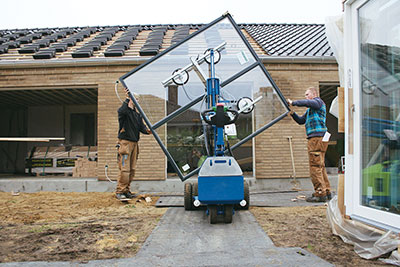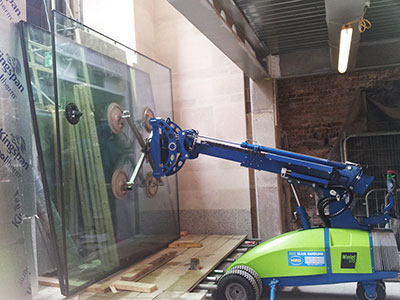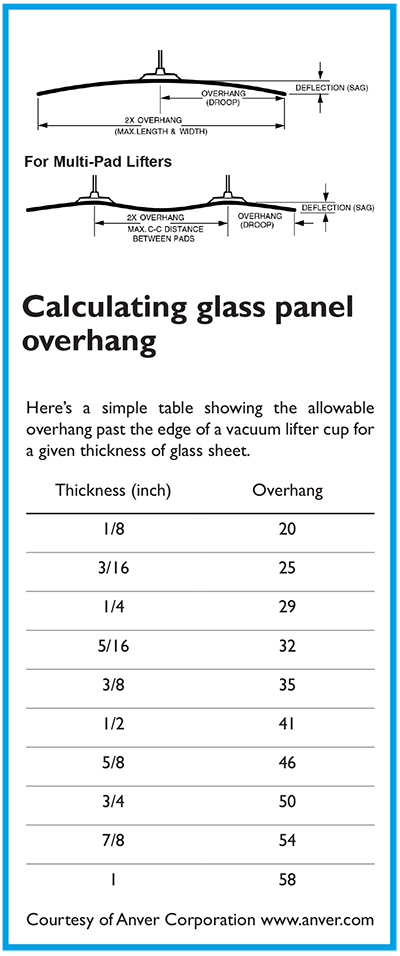
If you can handily flick a button or twirl a toggle with ease, then the
future of glass handling technology is within your grasp.
If you can handily flick a button or twirl a toggle with ease, then the future of glass handling technology is within your grasp. Automated and robotic material handlers are becoming de rigueur in today’s workplace. “Lifting heavy panes of glass can be done with no effort on the part of the operator,” says Will Stayer, president of A.E. Sales, headquartered in Red Deer, Alta. “It’s all about not breaking your back – or the glass.”
 |
|
| As architects specify ever-larger glass panels, workers incur risk during installation. Robotic glass handling equipment is getting more versatile and reliable, enabling you to meet the challenges your customers pose without endangering your people.
|
Stayer’s company brings Reachmaster’s innovative Winlet 1265 robotic glass lifter into Canada. Reachmaster is a leading global supplier of compact aerial equipment. “By using Winlet products you reduce, stress and strain on the installers, reduce the incidence of claims for bodily injury and experience less breakage and loss of product,” lauds Stayer. “Traditionally, most glass panels and doors are lifted and positioned manually. The largest are now often placed using crane or other machine-mounted handlers. Winlet handlers allows a glass installer to avoid the need for expensive cranes in many situations, while affording safe handling of larger panes from ground or fork level without the need for manual handling of larger panes.”
The cutting-edge lifter’s suction cups work by creating a vacuum seal on the glass using dual vacuum systems, dual vacuum pumps and four vacuum cups, and any one of the four vacuum cups can retain the weight of the lifted item on its own.
The front wheel trans-axle drive unit keeps weight on the front drive wheels and can incorporate a single wheel on each side or twin wheels on each side to provide enhanced traction, balance and flotation on rough, uneven or soft terrain. “We also feature wheeled outrigger arms for the stability of heavy and wide loads,” Stayer states, adding that track mounted and fork mounted options that allow mounting on telehandlers are also offered.
Using the Winlet 1265, window elements of up to 1,265 pounds can be lifted, transported and installed. With the ability to place the glass more precisely and more efficiently, faster installations can be done and minimizing chances of damaging the glass.
The battery-powered robotic unit weighs 2,850 pounds, is about six feet, two inches in length and a space-hugging 35-inches wide. Its compact design can handle heavy elements through narrow doorways down to 36 inches wide (the Winlet 770 model can pass through a 30-inch doorway while carrying a glass panel). The Winlet can also grip tightly onto large smooth surfaced object. The vacuum system allows Winlet’s machines to handle glass panels for most applications,while additional vacuum cup selections enable handling of more porous surfaces such as concrete slabs.
An intuitive visual approach on the remote control panel allows the operator to be up close to the workstation for easier installation without manually handling the glass. The operator selects the function needed on a diagram of the machine itself and then actuates the proportional control to manipulate that function. The vacuum is measured with gauges on the machine that indicate the vacuum status in bar and PSI. Two indicator lights on the control panel indicate the achievement of the vacuum in the two separate vacuum zones.
Hydraulic proportional controls allow the operator to more precisely control each movement of the glass in various directions by making the movement proportional to the movement of his own hand on the controls. Notes Stayer, “If a vacuum seal can be created on the surface in question and the weight is within machine operating range, then it can be handled.”
Outriggers are a safety feature of the 1265. These fold-out arms are sited near the base of the machine and equipped with solid wheels for additional safety when moving large, heavy panels over a surface. “They can prevent a sudden movement to either side if the machine rolls over an object or a hole in the surface being traversed,” Stayer points out.
Winlet’s five-model robotic lifters range in price from $35,000 to $85,000 depending on the model, lifting capability, drive/mount mechanism and the degree of automation.
As for maintenance, Stayer insists very little is required for Winlet lifters. “Because they run on batteries, you need to make sure the machine is plugged into 110-volt electrical outlet at the end of every shift,” he says. Replacement of batteries varies depending on usage hours. “The unit’s flexibility, reduction in operator fatigue and simple operation, will help increase the speed and efficiency of panel placement as well as avoiding unsafe situations, are all features of these Winlet material handlers,” he concludes.
Increasingly deployed across most industries, heavy-duty material handling employing robots and other sophisticated technologies are, despite substantial capital investment costs, are racking up positive results through throughput improvements and boosts in flexibility and consistency while decreasing hazards for workers and the need for additional conveyance systems in manufacturing and warehouse distribution centers.
New ways of designing architectural facades where higher, bigger and self-supporting glass are the order of the day create tough challenges for glass producers’ in-house production, handling and transportation operations.
Laying it (gently) on the line are the computer-driven intelligent stackers made by German-based Grenzebach Maschinenbau, a major supplier of glass products.
 |
|
| The new robotic glass handling machines are built with a compact footprint and powerplants that emit few or no noxious gases – perfect for working in confined indoor spaces.
|
“During handling, it is essential that the (glass) sheets be stacked without scratches onto special racks,” says Franz Krommer, the company’s glass product manager. “With our new stacker generation, results include significantly higher cycle times, higher plate weights and safe handling of plates with a length of up to 16 meters.” These robotic systems are capable of taking off glass plates directly from the moving transport conveyor, correcting their alignment and creating precise glass stacks.
Grenzebach’s vacuum-powered stackers, which can handle plate weights up to 2,400 kilograms at a maximum three cycles per minute, provide glass producers and handlers flexibility, speedier work pace, enhanced peak load and plate size performance.
According to Krommer, his intelligent stackers, driven by servomotors with planetary gear trains, are now deployed and integrated into the company’s glass transit flow across the factory floor. “They can combine several functions in one machine,” he says. “Without additional mechanical components, these new stackers can be operated in various loading and unloading modes. The machine is entirely software controlled. Enabling the loading mode, for one, just needs a mouse click. The performance is adapted to the weight to be stacked. This means that the stacker is only operated at a speed which is actually required at that moment.”
And at this moment, Cynergy Ergonomics is stirring up a buzz with its product 15000 series of vacuum lifters. A cooler door manipulator, the 15000 is a range of vacuum lifters. Model 150 for example, which utilizes pneumatically powered vacuum cups, can hoist and rotate glass cooler doors through a wide array of motions. “Our lifters can lift, pitch, roll, rotate and transport various components,” says Mike Shannahan, owner of Cynergy Ergonomics, which also manufactures articulating arm manipulators, as well as sheet, panel and roll lifters at its St. Louis, Mo., facility. “For example, we will pick up a glass sheet from the vertical orientation, rotate it 90 degrees, and pitch it forward 15 degrees for insertion into a frame.”
Shannahan, who started his career designing military aircraft, did the engineering and design work for the 15000s. Price tagged from $25,000 to $35,000 (depending on the number of motions and/or articulations required), the unit is built for the long haul. “We recommend daily, monthly and annual maintenance inspections to keep it humming,” advises Shannahan. Cynergy vacuum lifters can lift and handle work pieces weighing over 5,000 pounds. “Loads which, in the past, had to be moved by several persons can now be handled easily and safely by a single person for a significant cost savings in labour and time,” he emphasizes.
Another recent introduction to the Canadian glass market, Jekko’s MPK20 is a solid tire, self-propelled pick-and-carry electric crane designed for lifting and transporting cargo raised on the boom. Commended as compact and flexible, it has a single running gear (at a top speed of 2.2 miles per hour, there’s no need for multiple gears) that uses run-on electric batteries. “It is also popular with the glazing industry for placing prefabricated curtain wall panels, building materials, panels, beams and industrial maintenance in general,” says Kris Berry, inside sales coordinator for Strongco in Burlington, Ont., the Canadian distributor of the MPK20 built in Italy by Ormet.
The MPK20 can be equipped with a walk-behind, hydraulic manipulator for glass and panels fully integrated with the functions and safety of the basic machine. Standard features on the unit include a wall charger, working lights, non-marking wheels, quick coupler and wireless remote control. It offers a two-ton maximum capacity, and is powered by a 24-volt DC battery. This 37-inch-wide machine with a maximum load capacity of 4,400 pounds, is electric over hydraulic with a telescopic 12-foot boom that’s moved by steering the machine itself. The MPK20’s boom cannot swivel or turn and therefore does not need outriggers in order to stabilize it from different angles.
A low-maintenance machine that comes with grease fittings for easier lubrication, Berry claims that the MPK20 is one of the safest lifters around. “The wireless radio remote control allows the operator to keep a safe distance from the load while maintaining functionality and accuracy,” he remarks. Working lights (green, amber, red) on the machine also give an indication of the allowable and over load capacity rating. “This mini-crane has applications well tailored to glass-handling,” he says.
Material handling is a bright spot in the use of robotics. And Stayer sees faster growth ahead for the technology. “Material handling robotics have improved rapidly and will continue to do so over the coming years,” he predicts. That’s great news for the glass industry.

|
|
Print this page
Leave a Reply